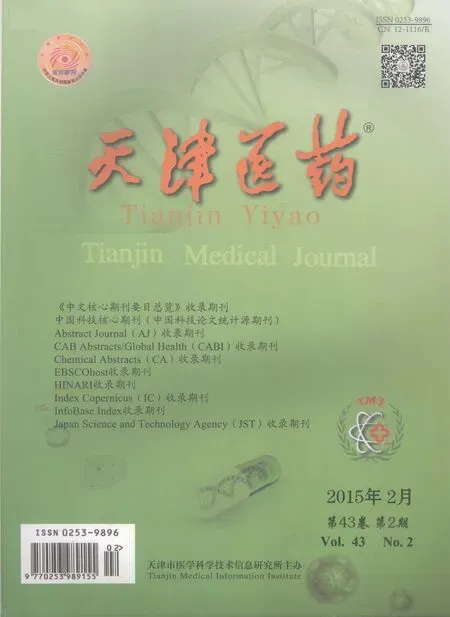血清LDL-C水平對老年男性高血壓性腦出血血腫擴大的預測作用
周紅霞,劉首峰,李玉旺,王欣,徐小林△
血清LDL-C水平對老年男性高血壓性腦出血血腫擴大的預測作用
周紅霞1,2,劉首峰3,李玉旺3,王欣3,徐小林3△
目的探討血清低密度脂蛋白膽固醇(LDL-C)水平對老年男性高血壓性腦出血急性期血腫擴大有無預測作用。方法收集我院2012年6月—2014年5月發病6 h以內的老年男性高血壓性腦出血患者108例,按發病時LDL-C水平分為LDL-C<2.49 mmol/L組和LDL-C≥2.49 mmol/L組,對2組患者入院時的收縮壓(SBP)、舒張壓(DBP)、血糖水平、凝血酶原時間(PT)、部分活化凝血酶時間(APTT)、纖維蛋白原(FIB)、血小板計數、血腫體積進行對比分析,并于發病24 h復查頭CT了解2組血腫擴大情況并進行比較。應用Logistic回歸模型,尋找對腦出血血腫擴大有預測價值的危險因素。結果2組患者入院時SBP、DBP、血糖水平、PT、APTT、FIB、PLT、血腫體積比較差異無統計學意義;LDL-C<2.49 mmol/L組的血腫擴大發生率高于LDL-C≥2.49 mmol/L組(34.21%vs 11.43%,P<0.05)。Logistic多元回歸分析顯示,LDL-C<2.49 mmol/L是血腫擴大的危險因素。結論老年男性急性期高血壓性腦出血患者LDL-C<2.49 mmol/L時提示血腫擴大風險較高,應及早采取相關治療措施。
脂蛋白類,LDL;顱內出血,高血壓性;血腫擴大;老年男性
高血壓性腦出血的早期血腫擴大是臨床中常見的現象,它增加了患者的致殘率和病死率。預測及預防血腫擴大是降低患者致殘率和病死率的關鍵環節,正日益受到臨床醫師的重視[1]。超早期檢測血腫擴大的分子生物學標志物,有助于及早篩查出血腫易擴大的患者并給予針對性治療。Rodri?guez-Luna等[2]的研究提示血清低密度脂蛋白膽固醇(LDL-C)水平可能與腦出血早期血腫擴大有關。筆者前期研究結果亦表明血清LDL-C與腦出血急性期血腫擴大有重要相關性[3]。隨著人口老齡化的進展,老年人口所占比例越來越高,對于老年男性這一特殊群體,LDL-C能否預測高血壓性腦出血急性期血腫擴大尚未得知。本研究采用前瞻性分析,連續收集2012年6月—2014年5月在我院就診、發病6 h內的108例老年男性腦出血患者進行動態觀察,探討LDL-C水平對其腦出血血腫擴大有無預測作用。
1 資料與方法
1.1一般資料108例患者年齡60~85歲,平均(70.1± 10.2)歲。納入標準:年齡≥60歲,經頭CT證實,符合1995年全國第4次腦血管病學術會議制定的腦出血的診斷標準,所有患者均于發病后24 h復查頭CT。排除標準:影像學檢查提示繼發于腦內異常結構的腦出血;6個月內有缺血性腦卒中發作的病史;伴隨可能影響結果的相關疾病,如嚴重的呼吸系統疾病、晚期腫瘤、甲狀腺功能亢進癥、肝腎功能損害、嚴重心功能不全及內分泌疾病等;腦動脈瘤破裂出血;外傷后腦出血;單純腦室出血;血液病及正使用抗凝藥物等。研究對象經醫院倫理委員會同意并簽署知情同意書。
1.2方法
1.2.1血腫擴大的影像學評定由2名經驗豐富的神經影像醫師對頭CT進行評價,以耳眥線為基線進行頭CT連續掃描,根據多田公式計算血腫體積(mL)=Л/6×A×B×C(A:血腫最大出血平面的最長直徑;B:與A垂直的直徑;C:血腫高度)。血腫擴大的判定標準為血腫體積<20 mL時,前后2張頭CT檢查血腫體積增加>33%或血腫體積≥20 mL時,2張頭CT檢查血腫體積增加>10%[4]。
1.2.2實驗室檢查研究對象均進行入院時收縮壓(SBP)、舒張壓(DBP)、入院時血腫體積測定,并進行空腹采血,檢測LDL-C、部分活化凝血酶時間(APTT)、凝血酶原時間(PT)、纖維蛋白原(FIB)、血小板計數、血糖。根據患者入院時LDL-C水平分為2組,LDL-C<2.49 mmol/L組(A組)和LDL-C≥2.49 mmol/L組(B組)。
1.2.3治療方法所有患者入院后均采用脫水降顱壓、改善腦代謝、控制血壓及補液等對癥治療。
1.3統計學方法采用SPSS 17.0統計軟件包進行分析,計量資料(符合正態分布)采用±s表示,2組間比較采用t檢驗;計數資料采用χ2檢驗,多元Logistic回歸分析確定其危險因素,以P<0.05為差異具有統計學意義。
2 結果
2.1LDL-C≥2.49 mmol/L組和LDL-C<2.49 mmol/ L組一般資料比較2組患者入院時SBP、DBP、血糖、PT、APTT、FIB、血小板計數、入院時血腫體積比較差異均無統計學意義,見表1;發病24 h復查頭CT血腫擴大LDL-C<2.49 mmol/L組(13/38)比例高于LDL-C≥2.49 mmol/L組(8/70),差異有統計覺得意義(χ2=8.161,P<0.05)。
Tab.1 Comparisons of baseline clinical data between two groups表1 LDL-C<2.49 mmol/L組和LDL-C≥2.49 mmol/L組患者一般資料比較 (±s)

Tab.1 Comparisons of baseline clinical data between two groups表1 LDL-C<2.49 mmol/L組和LDL-C≥2.49 mmol/L組患者一般資料比較 (±s)
*P<0.05;1 mmHg=0.133 kPa
組別A組B組t n 38 70入院SBP (mmHg)152.34±24.40 149.40±26.01 0.573入院DBP (mmHg)84.53±12.87 82.63±13.24 0.718入院血糖(mmol/L)5.74±1.32 6.39±2.42 1.756 PT (s)14.55±2.83 14.49±2.68 0.099組別A組B組t n 38 70 APTT (s)25.73±5.54 24.25±6.04 1.247 FIB (g/L)3.41±1.28 3.22±1.21 0.790血小板(×109/L)185.84±60.87 174.80±51.09 0.951入院血腫體積(mL)15.81±5.51 15.73±5.14 0.072
2.2LDL-C對腦出血血腫擴大的預測作用以血腫有無擴大(血腫無擴大=0,血腫擴大=1)作為因變量,以LDL-C水平(≥2.49 mmol/L=2,<2.49 mmol/L= 1)、入院時SBP、DBP、血糖、PT、APTT、FIB、血小板計數、血腫體積作為自變量,進行多因素Logistic回歸分析,結果顯示LDL-C<2.49 mmol/L是腦出血血腫擴大的危險因素,見表2。

Tab.2 Multiple Logistic regression analysis of risk factors of hemorrhage growth表2 血腫擴大影響因素的多因素Logistic回歸分析
3 討論
腦出血急性期血腫擴大在臨床上十分常見,是腦出血急性期神經功能缺損加重的重要原因[5]。Rizos等[6]的研究表明腦出血血腫擴大多在發病后24 h,24 h后很少有血腫繼續擴大的表現。因此,早期控制腦出血患者血腫擴大的危險因素,特別是發病后24 h,對防止血腫擴大有重要意義。鑒于此,本研究中亦采用了24 h界定有無血腫的擴大。老年男性高血壓性腦出血是臨床患者中非常重要的群體,本研究選擇了這一特殊群體為研究對象,探討LDL-C水平對老年男性高血壓性腦出血血腫擴大有無預測作用。
如何判斷急性腦出血患者血腫是否會繼續擴大,從而在早期給予其針對性的治療和處理,是神經科醫師急需解決的問題。目前報道的影響高血壓性腦出血早期血腫擴大的因素主要包括早期出血量的大小、出血形狀、出血部位、高血壓病、2型糖尿病、酗酒史、低纖維蛋白原血癥、腦內微出血、C反應蛋白水平等[7-9]。筆者前期研究結果表明血清LDLC<2.49 mmol/L與腦出血急性期血腫擴大有重要相關性[3]。本研究顯示LDL-C<2.49 mmol/L的患者中血腫擴大比例較高,多因素Logistic回歸分析顯示LDL-C<2.49 mmol/L是老年男性高血壓性腦出血急性期血腫擴大的危險因素。Rodriguez-Luna等[2]報道,低LDL-C水平與急性高血壓性腦出血早期血腫擴大、早期神經功能缺損癥狀加重及患者3個月預后有關,與本研究結果基本一致。Valappil等[10-11]的研究也提示低LDL-C水平可獨立預測腦出血后早期血腫擴大和早期神經功能惡化,同時低LDL-C水平也是腦出血后病死率增高的獨立危險因素。而國內關于LDL-C水平與高血壓性腦出血早期血腫擴大關系的研究還較少。低水平LDL-C增加腦出血急性期血腫擴大的機制目前尚不完全清楚,可能與過低的LDL-C水平破壞小血管壁的完整性及導致血小板聚集下降有關[12-13],有待于今后研究明確。
綜上,對老年男性患者這一特殊人群,發生急性腦出血時應及時檢測血清LDL-C,特別是對于LDL-C<2.49 mmol/L者需要密切觀察意識狀態,及時復查頭CT,以便及早采取相關治療措施。本研究亦存在一定局限性,因臨床實際情況,無法避免存在少數患者血腫急性期擴大但未到24 h復查頭CT即死亡者,研究結論尚需通過進一步增加樣本量并通過更為嚴謹的設計和前瞻性研究來證實。
[1]Brouwers HB,Chang Y,Falcone GJ,et al.Predicting hematoma ex?pansion after primary intracerebral hemorrhage[J].JAMA Neu?rol,2014,71(2):158-164.
[2]Rodriguez-Luna D,Rubiera M,Ribo M,et al.Serum low-density lipoprotein cholesterol level predicts hematoma growth and clinical outcome after acute intracerebral hemorrhage[J].Stroke,2011,42(9): 2447-2452.
[3]Liu SF,Xu XL.Relationship of serum low-density lipoprotein cho?lesterol level with hematoma growth after acute intracerebral hemor?rhage[J].China Journal of Modern Medicine,2013,23(16):85-87.[劉首峰,徐小林.血清低密度脂蛋白與腦出血血腫擴大的相關性研究[J].中國現代醫學雜志,2013,23(16):85-87].
[4]Dowlatshahi D,Demchuk AM,Flaherty ML,et al.Defining hemato?ma expansion in intracerebral hemorrhage:relationship with pa?tient outcomes[J].Neurology,2011,76(14):1238-1244.
[5]Du Q,Yang DB,Shen YF,et al.Plasma leptin level predicts hema?toma growth and early neurological deterioration after acute intrace?rebral hemorrhage[J].Peptides,2013,45(1):35-39.
[6]Rizos T,D?rner N,Jenetzky E,et al.Spot signs in intracerebral hemorrhage:useful for identifying patients at risk for hematoma en?largement[J]?Cerebrovasc Dis,2013,35(6):582-589.
[7]L?pp?nen P,Qian C,Tetri S,et al.Predictive value of C-reactive protein for the outcome after primary intracerebral hemorrhage[J].J Neurosurg,2014,29(1):1-6.
[8]Kawano-Castillo J,Ward E,Elliott A,et al.Thrombelastography detects possible coagulation disturbance in patients with intracere?bral hemorrhage with hematoma enlargement[J].Stroke,2014,45 (3):683-688.
[9]Di Napoli M,Parry-Jones AR,Smith CJ,et al.C-reactive protein predicts hematoma growth in intracerebral hemorrhage[J].Stroke,2014,45(1):59-65.
[10]Valappil AV,Chaudhary NV,Praveenkumar R,et al.Low cholester?ol as a risk factor for primary intracerebral hemorrhage:A case-con?trol study[J].Ann Indian Acad Neurol,2012,15(1):19-22.
[11]Gu B,Zhao YC,Yang ZW,et al.HindIII polymorphism in the lipo?protein lipase gene and hypertensive intracerebral hemorrhage in the Chinese Han population[J].J Stroke Cerebrovasc Dis,2014,23 (6):1275-1281.
[12]Lee JG,Koh SJ,Yoo SY,et al.Characteristics of subjects with very low serum low-density lipoprotein cholesterol and the risk for intra?cerebral hemorrhage[J].Korean J Intern Med,2012,27(3):317-326.
[13]Valappil AV,Chaudhary NV,Praveenkumar R,et al.Low cholester?ol as a risk factor for primary intracerebral hemorrhage:A case-con?trol study[J].Ann Indian Acad Neurol,2012,15(1):19-22.
(2014-08-09收稿2014-10-24修回)
(本文編輯李國琪)
Clinic application of serum low-density lipoprotein cholesterol level in predicting expansion hematoma in elderly male patients with acute hypertensive intracerebral hemorrhage
ZHOU Hongxia1,2,LIU Shoufeng3,LI Yuwang3,WANG Xin3,XU Xiaolin3△
1Graduate School of Tianjin Medical University,Tianjin 300070,China;2Tianjin Hospital;3 Department of Neurology,Tianjin Huanhu Hospital
△Corresponding AuthorE-mail:hhyyxxl@163.com
ObjectiveTo investigate whether serum level of low-density lipoprotein cholesterol can predict the expan?sion of hemorrhage growth in elderly male patients with acute hypertensive intracerebral hemorrhage.MethodsPatients(n= 108)who visited our hospital with from June 2012 until May 2014 spontaneous hypertensive intracerebral hemorrhage with?in 6 hours of onset which is confirmed by initial computed tomography(CT)were sent to repeated CT within 24 hours of on?set.All selected patients were divided into the LDL-C≥2.49 mmol/L group and LDL-C<2.49 mmol/L group.Clinical data of these 2 groups were compared and the relationships of hematoma growth and its risk factors were analyzed.Results Baseline blood pressure,the level of blood glucose,PT,APTT,FIB,PLT and hemorrhage volume did not differ significantly between the LDL-C≥2.49 mmol/L group and LDL-C<2.49 mmol/L group.The ratio of hemorrhage growth in LDL-C<2.49 mmol/L group was significantly higher than that in LDL-C≥2.49 mmol/L group(34.21%vs 11.43%).Multiple logistic regres?sion analysis showed that LDL-C<2.49 mmol/L was the only risk factor contribute to hemorrhage growth.ConclusionPa?tients with LDL-C<2.49 mmol/L in acute intracerebral hemorrhage are of high risk of hemorrhage growth so early attention and appropriate procedure are needed to prevent or slow its growth.
lipoproteins,LDL;intracranial hemorrhage,hypertensive;hemorrhage growth;elderly men
R743.2
ADOI:10.11958/j.issn.0253-9896.2015.02.018
天津市衛生局科技基金項目(2012KZ033)
1天津醫科大學研究生院(郵編300070);2天津市天津醫院神經科;3天津市環湖醫院神經內科
周紅霞(1979),女,主治醫師,碩士在讀,主要從事腦血管病的診斷、治療及康復的研究
△E-mail:hhyyxxl@163.com

